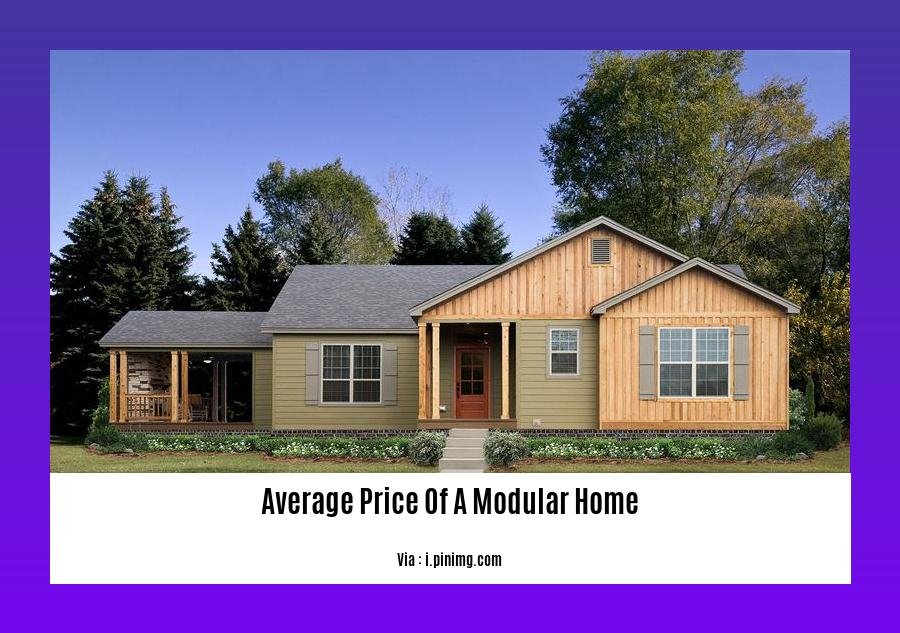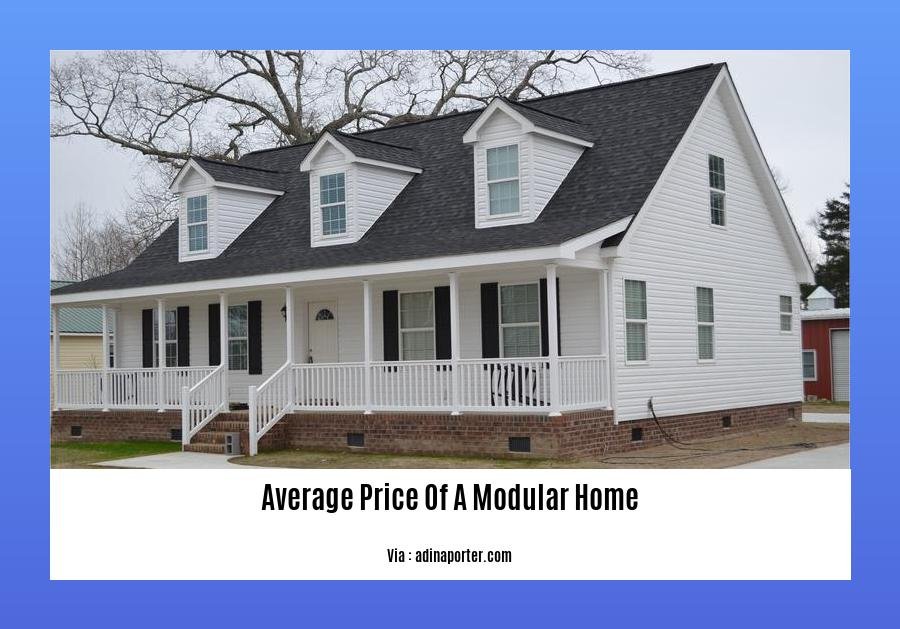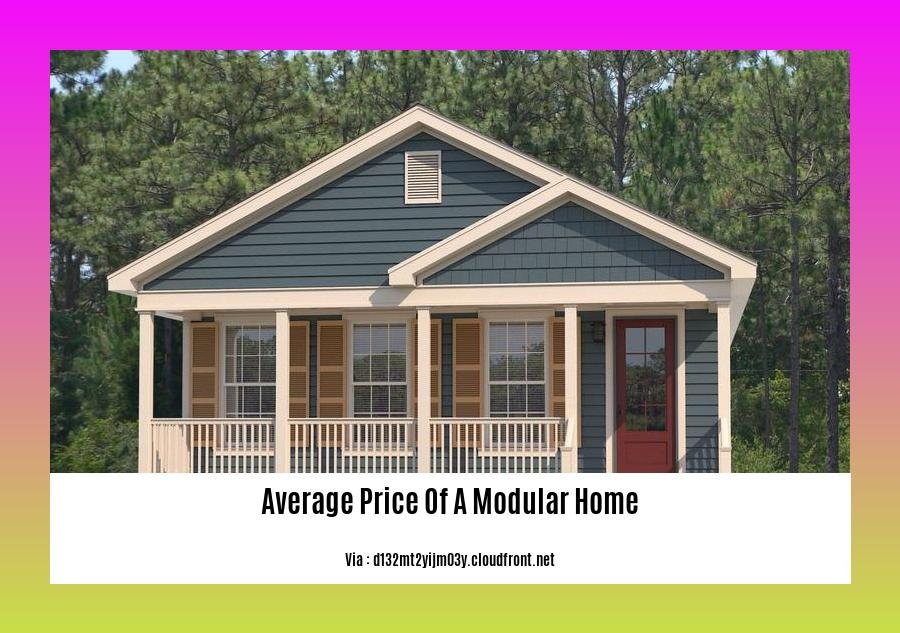Step into the realm of modular homes, where affordability meets customization in a seamless blend of comfort and efficiency. [1. Unveiling the Average Price of a Modular Home: A Comprehensive Analysis] delves into the intricate factors that influence the pricing of these innovative structures, guiding you through the intricacies of material choices, construction methods, and market trends. Discover the secrets behind the varying costs, empowering you to make informed decisions as you embark on your modular home journey.
Key Takeaways:
-
The average price of a modular home, including delivery, ranges from $150,000 to $300,000 in the United States.
-
Modular homes come in various price ranges, starting at $80,000 for a small one-bedroom home and exceeding $1 million for a luxury mansion.
-
Size, style, customization, location, and the company producing the home all influence the final cost.
-
The typical cost per square foot for a modular home falls between $50 and $100.
-
Additional costs like land, setup, and installation can add $30 to $60 per square foot.
Average Price of a Modular Home

Are you considering the allure of modular homes, yet perplexed by the murky pricing waters? Let’s dive in and uncover the factors that sculpt the average price of a modular home!
The Enigma of Modular Home Pricing
The realm of modular homes unfolds a symphony of price points, where factors like size, design, materials, and location orchestrate a dynamic dance. Unraveling this enigma demands a discerning eye and a keen grasp of the intricacies involved.
Symphony of Costs
-
Size: Every square foot spells a difference in the final tally. Larger homes naturally command a higher price tag.
-
Design: Complexity reigns supreme here. Ornate designs with intricate details demand a premium compared to simpler, streamlined layouts.
-
Materials: Quality materials amplify the price. Opting for top-notch finishes and appliances elevates the overall cost.
-
Location: Regional variations are a reality. Labor costs and local regulations can influence the final figure.
-
Manufacturer: Reputation and expertise come at a price. Established manufacturers with a proven track record may charge more than their less experienced counterparts.
Unveiling the Price Spectrum
The average price of a modular home in the United States paints a broad canvas, ranging from $150,000 to $300,000, including delivery. However, this mere brushstroke conceals a kaleidoscope of possibilities.
-
Modest abodes, typically one-bedroom homes, start their journey at around $80,000.
-
At the opposite end of the spectrum, luxury modular mansions can soar beyond $1 million.
-
The per-square-foot cost usually falls between $50 and $100.
Beyond the Base Price
The base price is just the tip of the iceberg. Additional costs lurk beneath the surface, ready to inflate the final bill.
-
Land acquisition, if not already in your possession, can set you back anywhere from $10,000 to $100,000.
-
Transportation expenses hinge on the distance between the manufacturing facility and your desired location.
-
Installation fees, handled by professionals, can range from $30 to $60 per square foot.
Navigating the Modular Maze
Venturing into the realm of modular homes demands careful consideration. Seek out reputable manufacturers with a proven track record of excellence. Thoroughly examine their designs and materials to ensure alignment with your vision and budget.
Remember, the average price of a modular home is merely a starting point. The final figure will depend on your unique requirements and aspirations. Embrace the journey, unveil the true cost, and make informed decisions to craft the modular home of your dreams!
-
Seeking respite from care homes? Explore our comprehensive article showcasing alternatives to care homes here: ../alternatives-to-care-homes.
-
Keen on acquiring an Amish-built home? Delve into the captivating insights and delve into the fascinating realm of Amish-built homes by visiting our comprehensive resource: ../amish-built-homes-cost.
-
Discover the radiant Angels Care Home Health facilities, providing exceptional healthcare services tailored to your needs. Explore their esteemed Angels Care Home Health locations here: ../angels-care-home-health-locations.
-
Navigating through the complexities of nursing home care for dementia? Our guide on average length of stay in a nursing home for dementia will shed light on crucial factors and considerations. Visit: ../average-length-of-stay-in-nursing-home-for-dementia.
Regional variations: cost differences across different areas and why

So, you have your sights set on a modular home—that’s exciting! But before diving headfirst, it’s essential to understand the price range and factors influencing the cost.
The average price tag for a modular home can vary widely depending on where you plan to set up your dream abode. Regional variations: cost differences across different areas and why? Let’s break down the reasons behind these discrepancies.
1. Labor Costs Have a Big Impact
The cost of labor is a significant factor in determining the overall price of a modular home. In areas with higher labor costs, such as certain urban centers, the price of your home will likely be higher compared to regions with lower labor rates.
2. Material Costs Can Vary Too
The materials used to construct your modular home can also significantly impact its price. If you choose high-end materials like granite countertops and hardwood floors, your home’s cost will naturally be higher than if you opt for more budget-friendly options.
3. Transportation Costs: The Journey to Your Site
The distance between the manufacturing facility and your home site plays a role in determining the transportation costs. Longer distances mean higher transportation costs, as the modules need to be carefully transported to your location.
4. Local Regulations and Permit Fees
Local regulations and permit fees can vary from place to place. These fees can add up and impact the overall cost of your modular home.
5. Land Costs: The Foundation of Your Home
The cost of land can vary drastically depending on the region. Urban areas with limited land availability tend to have higher land costs compared to rural areas with more land options.
6. Manufacturer’s Reputation and Experience
The reputation and experience of the manufacturer can also influence the price of your modular home. Well-established and reputable manufacturers may charge more for their products due to the quality and reliability associated with their brand.
7. Size and Complexity of Your Dream Home
The size and complexity of your modular home design directly impact its cost. Larger homes with intricate designs and multiple stories will naturally cost more than smaller, simpler homes.
8. Customization Level: Making It Your Own
The level of customization you desire for your modular home also affects its price. Unique designs, specific material choices, and intricate layouts will all contribute to a higher cost.
9. Financing Options and Local Market Conditions
Financing options available in different regions can also influence the cost of your modular home. Additionally, local market conditions, such as supply and demand, can impact pricing.
10. Climate Considerations: Adapting to Your Environment
The climate in your region can also affect the cost of your modular home. Homes designed to withstand extreme weather conditions, such as hurricanes or earthquakes, may require additional materials and construction techniques, leading to higher costs.
Key Takeaways:
- Regional variations in labor costs, material costs, transportation costs, local regulations, land costs, manufacturer’s reputation, home size and complexity, customization level, financing options, local market conditions, and climate considerations can all contribute to price differences in modular homes across different regions.
- Understanding these factors can help you make informed decisions and budget accordingly when purchasing a modular home.
- Be prepared for price variations depending on the region you choose.
Relevant Sources:
- The Cost of Modular Homes: A Complete Guide
- Factors That Affect the Cost of a Modular Home
Additional considerations: land costs, transportation expenses, installation fees
A modular home might look affordable on paper, but there's more to the full picture. Let's dive into the additional costs that can add up quickly:
Key Takeaways:
- The land matters: Whether you own land or are looking to purchase, location influences the price.
- Transportation expenses: Hauling your dream home from the factory to your land incurs transportation expenses.
- Installation fees: Professional installation onto your prepared site is a must, requiring skilled labor.
- Site preparation: Leveling, utility connections, and foundation costs can vary depending on your plot’s conditions.
The Land: A Foundation for Your Modular Home
- Location, location, location! The land cost can significantly impact your budget. Urban or sought-after areas come with a higher price tag compared to rural locations.
- Whether you already own land or are in the market, research local land prices and consider the long-term value of the area.
Transportation Expenses: The Journey to Your Site
- Once your modular home leaves the factory, it embarks on a journey to your prepared site. The distance between the two determines transportation costs.
- Longer distances mean higher transportation fees. Be prepared for additional fees if your site is hard to access or requires specialized equipment.
Installation Fees: Ensuring a Smooth Setup
- Professional installation is crucial for the safety and longevity of your modular home.
- Skilled labor is required to handle the delicate process of setting up your home on its foundation.
- Installation fees can vary depending on the size and complexity of your modular home.
Site Preparation: Getting Your Land Ready
- Before your modular home arrives, your land needs to be readied for its arrival.
- This includes leveling the ground, installing utilities like water and electricity, and preparing the foundation.
- Depending on the condition of your land, costs can vary. Extensive preparation means higher expenses.
Additional Expenses Amidst the Excitement
- Additional expenses lurk beyond the modular home’s price tag. Think about landscaping, driveways, decks, and porches.
- These extras quickly add up, so plan and budget accordingly.
Understanding Price Factors Is Crucial for Informed Decision-Making When Buying a Modular Home
When it comes to modular homes, understanding the factors that influence their cost is vital to making an informed decision about purchasing one.
Modular homes, which are factory-built and assembled on-site, have gained popularity for their efficiency, affordability, and customizable designs, but their price tags can vary widely. Here, we’ll dive into the key components that determine the cost of modular homes.
Modular Home Pricing Factors
-
Size: The size of your modular home, measured in square feet, plays a significant role in determining its price. Larger modular homes naturally cost more than smaller ones.
-
Complexity of Design: If you opt for a modular home with intricate design features, such as vaulted ceilings, bay windows, or multiple stories, be prepared for a higher cost. Simple, rectangular designs tend to be more economical.
-
Materials: The materials used in the construction of your modular home will also impact its price. Higher-quality materials, such as solid wood, stone, or composite siding, typically cost more than standard materials like vinyl or metal.
-
Labor Costs: Modular homes are built in factories, but there are still labor costs associated with their construction. These costs can vary depending on the region, the manufacturer, and the complexity of the design.
-
Manufacturer’s Reputation: Established modular home manufacturers with a strong reputation for quality and reliability may charge more than lesser-known companies. It’s worth researching the manufacturer’s track record before making a purchase.
Key Takeaways:
-
Size Matters: The larger your modular home, the more it will cost.
-
Design Details: Intricate designs and additional features increase the price.
-
Material Choices: Higher-quality materials come with a higher price tag.
-
Labor and Reputation: Labor costs and the manufacturer’s reputation influence the final cost.
-
Location and Other Factors: Regional variations and additional expenses, such as land costs, can also impact the overall price.
Making an Informed Decision
To make an informed decision when purchasing a modular home, it’s crucial to carefully consider your needs, budget, and preferences. Clearly define your must-have features and be open to exploring different options to find a modular home that aligns with your vision and financial constraints.
Citations:
- Modular Homeowners
- Discount Lots
FAQ
Q1: What is the average cost of a modular home in the United States?
A1: The average cost of a modular home in the US typically ranges from $150,000 to $300,000, including delivery. However, prices can vary depending on factors such as size, style, customization, location, and the company.
Q2: What are the factors that influence the price of a modular home?
A2: The price of a modular home is influenced by several factors, including the size of the home, the style and complexity of the design, the level of customization desired, the location of the home, and the reputation and quality of the modular home company.
Q3: How does the cost of a modular home compare to that of a traditional stick-built home?
A3: Modular homes are generally more affordable than traditional stick-built homes. On average, modular homes cost between $50 and $100 per square foot, while traditional stick-built homes can cost between $100 and $200 per square foot.
Q4: How long does it take to build a modular home?
A4: The construction time for a modular home is typically shorter than that of a traditional stick-built home. Modular homes are built in sections in a factory, and then assembled on-site. The entire process, from start to finish, can take anywhere from a few weeks to a few months, depending on the size and complexity of the home.
Q5: Are modular homes energy-efficient?
A5: Yes, modular homes are often built with energy-efficient materials and techniques, which can lead to lower monthly utility costs. Modular homes are typically well-insulated and sealed, and they may also be equipped with energy-efficient appliances and fixtures.
- Backsplash For Gray Cabinets: Choosing the Right Backsplash Style - December 13, 2025
- Gray And White Backsplash: Ideas For Timeless Style - December 12, 2025
- Gray Kitchen Backsplash Ideas: Find Your Perfect Gray Tile - December 11, 2025









